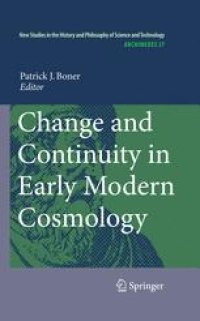
Ebook: Change and Continuity in Early Modern Cosmology
Author: Patrick J. Boner
- Genre: Physics
- Tags: History of Science, Astronomy Astrophysics and Cosmology, History of Philosophy, History of Mathematics
- Series: Archimedes: New Studies in the History and Philosophy of Science and Technology 27
- Year: 2011
- Publisher: Springer
- Language: English
- pdf
Viewed as a flashpoint of the Scientific Revolution, early modern astronomy witnessed a virtual explosion of ideas about the nature and structure of the world. This study explores these theories in a variety of intellectual settings, challenging our view of modern science as a straightforward successor to Aristotelian natural philosophy. It shows how astronomers dealt with celestial novelties by deploying old ideas in new ways and identifying more subtle notions of cosmic rationality. Beginning with the celestial spheres of Peurbach and ending with the evolutionary implications of the new star Mira Ceti, it surveys a pivotal phase in our understanding of the universe as a place of constant change that confirmed deeper patterns of cosmic order and stability.
Viewed as a flashpoint of the Scientific Revolution, early modern astronomy witnessed a virtual explosion of ideas about the nature and structure of the world. This study explores these theories in a variety of intellectual settings, challenging our view of modern science as a straightforward successor to Aristotelian natural philosophy. It shows how astronomers dealt with celestial novelties by deploying old ideas in new ways and identifying more subtle notions of cosmic rationality. Beginning with the celestial spheres of Peurbach and ending with the evolutionary implications of the new star Mira Ceti, it surveys a pivotal phase in our understanding of the universe as a place of constant change that confirmed deeper patterns of cosmic order and stability.
Viewed as a flashpoint of the Scientific Revolution, early modern astronomy witnessed a virtual explosion of ideas about the nature and structure of the world. This study explores these theories in a variety of intellectual settings, challenging our view of modern science as a straightforward successor to Aristotelian natural philosophy. It shows how astronomers dealt with celestial novelties by deploying old ideas in new ways and identifying more subtle notions of cosmic rationality. Beginning with the celestial spheres of Peurbach and ending with the evolutionary implications of the new star Mira Ceti, it surveys a pivotal phase in our understanding of the universe as a place of constant change that confirmed deeper patterns of cosmic order and stability.
Content:
Front Matter....Pages i-xii
Introduction....Pages 1-6
The Reality of Peurbach’s Orbs: Cosmological Continuity in Fifteenth and Sixteenth Century Astronomy....Pages 7-32
Continuity and Change in Cosmological Ideas in Spain Between the Sixteenth and Seventeenth Centuries: The Impact of Celestial Novelties....Pages 33-50
Cornelius Gemma and the New Star of 1572....Pages 51-65
Johannes Kepler and David Fabricius: Their Discussion on the Nova of 1604....Pages 67-92
Kepler’s Copernican Campaign and the New Star of 1604....Pages 93-114
From Cosmos to Confession: Kepler and the Connection Between Astronomical and Religious Truth....Pages 115-133
Johannes Phocylides Holwarda and the Interpretation of New Stars in the Dutch Republic....Pages 135-152
Discovering Mira Ceti: Celestial Change and Cosmic Continuity....Pages 153-176
Back Matter....Pages 177-181
Viewed as a flashpoint of the Scientific Revolution, early modern astronomy witnessed a virtual explosion of ideas about the nature and structure of the world. This study explores these theories in a variety of intellectual settings, challenging our view of modern science as a straightforward successor to Aristotelian natural philosophy. It shows how astronomers dealt with celestial novelties by deploying old ideas in new ways and identifying more subtle notions of cosmic rationality. Beginning with the celestial spheres of Peurbach and ending with the evolutionary implications of the new star Mira Ceti, it surveys a pivotal phase in our understanding of the universe as a place of constant change that confirmed deeper patterns of cosmic order and stability.
Content:
Front Matter....Pages i-xii
Introduction....Pages 1-6
The Reality of Peurbach’s Orbs: Cosmological Continuity in Fifteenth and Sixteenth Century Astronomy....Pages 7-32
Continuity and Change in Cosmological Ideas in Spain Between the Sixteenth and Seventeenth Centuries: The Impact of Celestial Novelties....Pages 33-50
Cornelius Gemma and the New Star of 1572....Pages 51-65
Johannes Kepler and David Fabricius: Their Discussion on the Nova of 1604....Pages 67-92
Kepler’s Copernican Campaign and the New Star of 1604....Pages 93-114
From Cosmos to Confession: Kepler and the Connection Between Astronomical and Religious Truth....Pages 115-133
Johannes Phocylides Holwarda and the Interpretation of New Stars in the Dutch Republic....Pages 135-152
Discovering Mira Ceti: Celestial Change and Cosmic Continuity....Pages 153-176
Back Matter....Pages 177-181
....